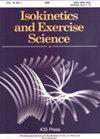女性下肢肌肉的峰值力矩:同心、偏心和等长收缩的比较研究
IF 0.7
4区 医学
Q4 ENGINEERING, BIOMEDICAL
引用次数: 0
摘要
背景:研究表明,男性在单独调整关节角度时,最大等长肌肉力矩可超过最大偏心肌肉力矩。然而,目前还没有女性肌肉力学的相关信息。目的:研究女性在同等条件下的最大肌肉力矩等级。方法:对 18 名年轻女性的踝关节、膝关节、髋关节屈肌和伸肌以及髋关节内收肌和外展肌的最大自主同心肌力矩、偏心肌力矩和等长肌力矩进行测试。所有受试者的肌群测试顺序相同,收缩类型的顺序也是随机的。所有动态收缩均以 60∘/s 的速度进行。等长力矩测试采用同心收缩的峰值力矩角。采用重复测量方差分析和事后 Bonferroni 校正来比较收缩类型之间的平均值。结果:所有肌群在三种收缩类型之间的最大力矩平均值都存在明显差异(p< 0.001)。同心肌力矩明显是最弱的收缩类型。在背屈、跖屈、膝关节屈曲和髋关节内收时,偏心收缩产生的力矩明显高于等长收缩。结论:女性在同心、偏心和等长收缩时,下半身肌肉的最大力矩存在明显差异。与之前针对男性的研究相比,女性在产生较高偏心肌肉力矩方面的能力优于其他收缩类型,这似乎是一种性别特异性收缩类型层次结构。在设计针对收缩类型的干预计划时,应考虑这些结果。本文章由计算机程序翻译,如有差异,请以英文原文为准。
Peak moments of lower extremity muscles in women: A comparative study of concentric, eccentric and isometric contractions
BACKGROUND: It has been demonstrated that maximum isometric muscle moment can surpass maximum eccentric muscle moment at individually adjusted joint angles in men. However, no information about these muscle mechanics is available for women. OBJECTIVE: To examine the maximum muscle moment hierarchywith equal conditions in women. METHODS: Maximum voluntary concentric, eccentric, and isometric muscle moments of ankle, knee, and hip flexors and extensors as well as hip adductors and abductors were tested in eighteen young women. The sequence of muscle group testing was the same for all subjects, and the sequence of contraction types was randomized. All dynamic contractions were performed at 60∘/s. Peak moment angle of concentric contractions was applied for isometric moment testing. A repeated measures ANOVA with posthoc Bonferroni correction was used to compare means between contraction types. RESULTS: Differences in maximum moment mean values between the three contraction types were apparent for all muscle groups (p< 0.001). Concentric muscle moment was significantly the weakest contraction type. Eccentric contractions generated significantly higher moments than isometric contractions in dorsiflexion, plantarflexion, knee flexion, and hip adduction. CONCLUSION: Significant differences in maximum lower body muscle moments exist between concentric, eccentric, and isometric contractions in women. Compared to previous research for men there appears to be a sex-specific contraction type hierarchy with women exhibiting superior ability to generate higher eccentric muscle moment relative to other contraction types. These results should be considered when designing contractiontype specific intervention programs.
求助全文
通过发布文献求助,成功后即可免费获取论文全文。
去求助
来源期刊

Isokinetics and Exercise Science
医学-工程:生物医学
CiteScore
1.20
自引率
14.30%
发文量
37
审稿时长
>12 weeks
期刊介绍:
Isokinetics and Exercise Science (IES) is an international journal devoted to the study of theoretical and applied aspects of human muscle performance. Since isokinetic dynamometry constitutes the major tool in this area, the journal takes a particular interest in exploring the considerable potential of this technology.
IES publishes studies associated with the methodology of muscle performance especially with respect to the issues of reproducibility and validity of testing, description of normal and pathological mechanical parameters which are derivable from muscle testing, applications in basic research topics such as motor learning paradigms and electromyography. The journal also publishes studies on applications in clinical settings and technical aspects of the various measurement systems employed in human muscle performance research.
The journal welcomes submissions in the form of research papers, reviews, case studies and technical reports from professionals in the fields of sports medicine, orthopaedic and neurological rehabilitation and exercise physiology.
 求助内容:
求助内容: 应助结果提醒方式:
应助结果提醒方式:


